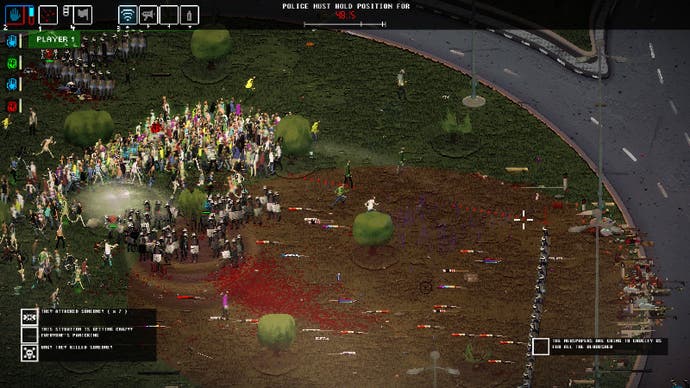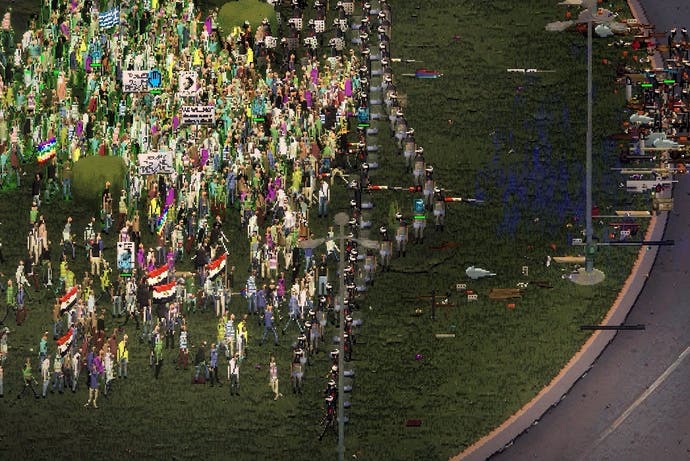Playing the Arab Spring in Riot - Civil Unrest
A fascinating curio finally hits Steam.
There are a number of ways to lose in Riot - Civil Unrest, a strange and jittery and deeply unnerving game that has just hit Early Access on Steam. Riot is, as the name suggests, a riot simulator. You can play as rebels or the security forces, each side with their own objectives and their own tactics. What unites everyone, though, are those different ways you can lose. You can fail to hold territory, of course - you can be driven back or have your surge repelled. But you can also be victorious on the streets and then discover that the political cost of your brutality is too much. You can lose the war by winning the battle.
What a fascinating game this is. Just the sort of thing I feel I should be playing as I wake up each morning to see what has been tweeted overnight. Yet while Riot is timely - perhaps because it is timely - it is not a great deal of fun to play. This is not a criticism, weird as it sounds. I think Riot would be a failure if it was fun to play.
January 25th, 2011. Tahrir Square. Riot likes to draw its scenarios from the real world, and the Egyptian campaign is the stand-out for me so far. I have yet to play as the security forces here, because I cannot work myself up to it. Instead I play as the people kicking off the Egyptian revolution.
Or trying to, anyway. Riot puts you in charge of a huge crowd in Tahrir Square, and it also divides that crowd into a series of distinct squads, which you can move around individually. You can tell them where to move to, and you can tell them whether to be defensive or offensive - although you may lose control over this choice as things start to go south. Before you play, you can choose a selection of things to bring with you to help out. Megaphones allow you to regroup, boosting attention and discipline. Social media allows you to call in reinforcements. There are things to lessen the impact of tear gas. Then there are things like Molotovs. The security forces get their own options, of course, and those options are equally imprecise and given to creating unforeseen consequences. Even on harder difficulties I tend to leave the Molotovs at home.

I love the sense of delay that Riot has. You tell a group to move, and there is this lovely chuggy pause to it, the sense of an idea filtering through a large group of people before an action is then taken. I love the way that the crowds are depicted, in thin, rather fragile pixel-art, the edges of the lines blurred and flaring as if coming to you through a patchy CNN video feed. Mostly, I love the way that people moving en masse, clashing in the streets, surging and falling back, make me think of fluid dynamics, of simulations of water rather than crowds. This is a violent game - people die, and you're aware, the whole time, that they were once, and quite recently, real people driven to march on real streets. Maybe Riot is only playable from this remove, from this lofty vantage point, from a perspective where the individuals become a crowd and the crowd itself becomes an individual thing in its own right.
Updates are delivered to either side in a sort of Twitter feed, but in truth, Riot is a surprisingly easy game to read as it is taking place. It's never in doubt why you are losing, or how you are losing, and the game's mechanical bias - the best way to win for either side is to remain as peaceful as possible - feels like a spine of morality running through the whole thing. The designer's specific morality, it feels like a personalising element in a game about huge groups of people. It feels like a thumbprint pressed into the paint.
Riot's path to Early Access has not been easy. There have been crowd-sourcing campaigns and long silences and near-cancellations and unhappy backers. Its current form is scrappy, with an ugly UI and fiddly controls. But there is something here that feels vivid and human and darkly fascinating. I have stopped playing Riot for now, but I will not forget it for quite a while.

